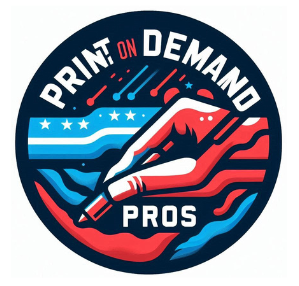Copyright is like a superhero for your creations, swooping in to protect your work from sneaky imitation or theft. It gives you the power to control who can use, share, or distribute your creative pieces, whether it’s art, music, writing, or any intellectual property you’ve poured your heart into.
Licensing, on the other hand, is more like giving a playground permission slip. It allows others to use your copyrighted work under specific conditions. There are different types of licenses – some let people change or build on your work, while others don’t allow modifications at all. Each license type has its own perks, so understanding them is like having a map to navigate the creative landscape.
In the print-on-demand world, copyright and licensing are your best buddies. They ensure your designs or content remain yours while giving you flexibility to reach broader audiences through sales and collaborations. It’s a fast-growing industry, and knowing how to protect what’s yours while sharing your work is key to success.
Printing businesses using a print-on-demand model rely heavily on content ownership and rights. Without proper copyright and licensing, you could end up facing legal headaches or losing control over your creations. That’s why it’s crucial to grasp the basics, which can save you time and trouble down the line.
Navigating Copyright in Print on Demand
Copyright laws are the backstage pass for creators in the print-on-demand business. They determine how your designs can be used, who can reproduce them, and what happens if someone uses them without permission. In this realm, understanding these laws is as crucial as having a killer design.
Many people think once they create something, it’s free to use on any platform. That’s a big misconception. Even if you make a design, the rules about where and how you can sell it are driven by copyright laws. These laws don’t change just because you’re using a different medium like print-on-demand.
A common trap is assuming everything you find online is free game. Nope, that meme you like or that catchy quote has a creator, and their rights matter. Knowing when you need permissions and when something falls under fair use can help keep your business out of hot water.
There are cases where creators have run into copyright snags in print-on-demand. For instance, using licensed characters on apparel without permission can lead to serious legal issues. Learning from these tales can guide you in making smarter choices about what designs to put out there.
Staying informed on copyright is like having an owner’s manual for your business. It helps clarify what you can legally produce and sell, enabling you to streamline your processes. With correct applications of these laws, your creativity can thrive in print-on-demand without unnecessary stress.
Licenses Explained: What You Need to Know
Licenses are like choosing your dance partners in the creative world—they determine who gets to play with your work and how much freedom they have. Getting this right is crucial for any print-on-demand business.
It starts with knowing the difference between exclusive and non-exclusive licenses. An exclusive license is a bit like an exclusive relationship. You’re granting rights to just one party, which can often be more lucrative. Non-exclusive is much more laid-back, allowing multiple partners access to your designs.
Creative Commons licenses are a whole different ball game, offering flexibility while still protecting your rights. They’re particularly beneficial for creators who want some exposure while maintaining control over their creations. By selecting the right type of Creative Commons license, artists can set clear boundaries about how others can use their work.
While all these options might seem overwhelming, staying informed is your best bet against getting caught in tricky legal waters. Look out for traps like unintentionally granting more rights than you intended or not covering enough protections, which can have lasting impacts.
Understanding licensing is not just about knowing your options but also about strategically choosing the right one for your goals. This way, you keep your creative content protected while ensuring it reaches the audiences who appreciate it most. A strategically chosen license can be a powerful tool in expanding your brand’s reach without losing ownership.
Protecting Your Work: Copyright Strategies for Creators
Securing copyright for your creative output is like fitting your work with a security system. It keeps your intellectual property safe and ensures you’re recognized as its rightful owner. Let’s dive into some strategies that help keep your designs under lock and key.
First off, always make sure your work is registered appropriately. While copyright is automatically yours when you create something, registering it officially can give you stronger legal grounding if disputes arise. This step is simple but might save your business a boatload of hassle.
Transparency is key when working with others. Whether it’s contractors or collaborators, having agreements in place is essential. Clear contracts help avoid misunderstandings about who owns what and how the creations can be used.
Frequent monitoring of your work online is another tactic. Regular checks to ensure your designs aren’t being used without permission helps catch potential infringements early, allowing swift action. There are tools out there that make monitoring simple and efficient.
Creativity thrives on collaboration but protecting your content doesn’t mean you have to work alone. Sharing your work with trusted partners or platforms that respect your rights can lead to opportunities for growth without the risk of losing control over your art.
With these strategies, you can safeguard your creative assets while focusing on what you do best—designing great products. It’s about smart protection, not stifling creativity, to create a healthy balance between freedom and security.
Optimizing Your Print On Demand Business with Licensing
Leveraging licensing is like having a secret weapon for unlocking new potential in your print-on-demand business. By using licensed artwork, you can expand your catalog and bring fresh, diverse products to your customers, helping you stand out in a competitive market.
Strategic partnerships can be game-changers. Teaming up with artists or other creators through licensing agreements lets you offer unique products without having to design every single item yourself. This can free up time and resources while broadening your product range.
Keep an eye on licensing trends. The print-on-demand world is fast-paced, and being aware of what’s popular or emerging can give you a leg up. For example, exclusive designs with popular themes or characters can draw in new customers and boost sales.
Licensing isn’t just about using other people’s work. It’s also about getting your own designs out there. Licensing your creations to different platforms can help you reach new audiences and find income streams you hadn’t considered before.
As the print-on-demand landscape evolves, so do opportunities. Staying adaptable with your licensing strategies can ensure you’re always a step ahead. Embracing change while protecting your core assets is the key to sustained growth and success in this dynamic field.




This is very informative. I’m particularly interested in the challenges of navigating copyright laws when creating custom designs. From your experience, what are some effective strategies for ensuring that designs are both original and legally compliant? Personally, I’ve found that working closely with a legal expert can help avoid potential pitfalls. Additionally, how do you handle situations where a design might unintentionally infringe on existing copyrights? It’s a complex area, and I’m curious about your approach to managing these risks while fostering creativity.